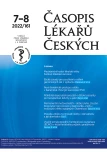Practical recommendations for the management of children after kidney and liver transplantation
Authors:
Jakub Zieg 1; David Bauer 2; Vlasta Krejčová 1; Lucie Gonsorčíková 2
Authors‘ workplace:
Pediatrická klinika 2. LF UK a FN Motol, Praha
1; Pediatrická klinika 1. LF UK a FTN, Praha
2
Published in:
Čas. Lék. čes. 2022; 161: 296-302
Category:
Guidelines
Overview
The number of pediatric solid organ transplantations is growing. This therapy leads often to better quality of life but also brings some specific complications. Our review summarizes practical recommendations for long-time care of the children after kidney and liver transplantation. The knowledge of the issues related to transplantation is essential for the first contact physicians, whose cooperation with transplant centre contributes highly to adequate management of these children.
Keywords:
kidney transplantation – liver transplantation – adherence – sport – medication
Sources
1. Zieg J, Skálová S. Dětská nefrologie do kapsy. Mladá fronta, Praha, 2019.
16. Pham YH, Miloh T. Liver transplantation in children. Clin Liver Disease 2018; 22 : 807–821.
30. Dreno B. Skin cancers after transplantation. Nephrol Dial Transplant 2003; 18 : 1052–1058.
37. Bartosh S, Dipchand A, Chavers B, Pediatric Kidney Transplantation. A Guide for Patients and Families. American Society of Transplantation, 2015. Dostupné na: www.erknet.org/patient_info/Pediatric_Kidney_Transplantation_BrochureAST__-_final_copy_2015-06-27_0.pdf
Labels
Addictology Allergology and clinical immunology Angiology Audiology Clinical biochemistry Dermatology & STDs Paediatric gastroenterology Paediatric surgery Paediatric cardiology Paediatric neurology Paediatric ENT Paediatric psychiatry Paediatric rheumatology Diabetology Pharmacy Vascular surgery Pain management Dental HygienistArticle was published in
Journal of Czech Physicians

- Advances in the Treatment of Myasthenia Gravis on the Horizon
- Metamizole vs. Tramadol in Postoperative Analgesia
- What Effect Can Be Expected from Limosilactobacillus reuteri in Mucositis and Peri-Implantitis?
- The Importance of Limosilactobacillus reuteri in Administration to Diabetics with Gingivitis
- The Importance of Hydration in Wound Healing
Most read in this issue
- Permanent urethral catheter – a good servant, but bad master: Guidelines for prevention, diagnosis, and treatment of catheter-associated urinary tract infections
- COVID-19 infection elicits textbook immune response
- Prescription rules of hormone replacement therapy and its alternative
- The use of extracorporeal membrane oxygenation in the treatment of critical course of pneumonia
